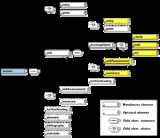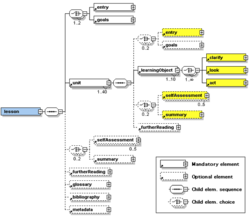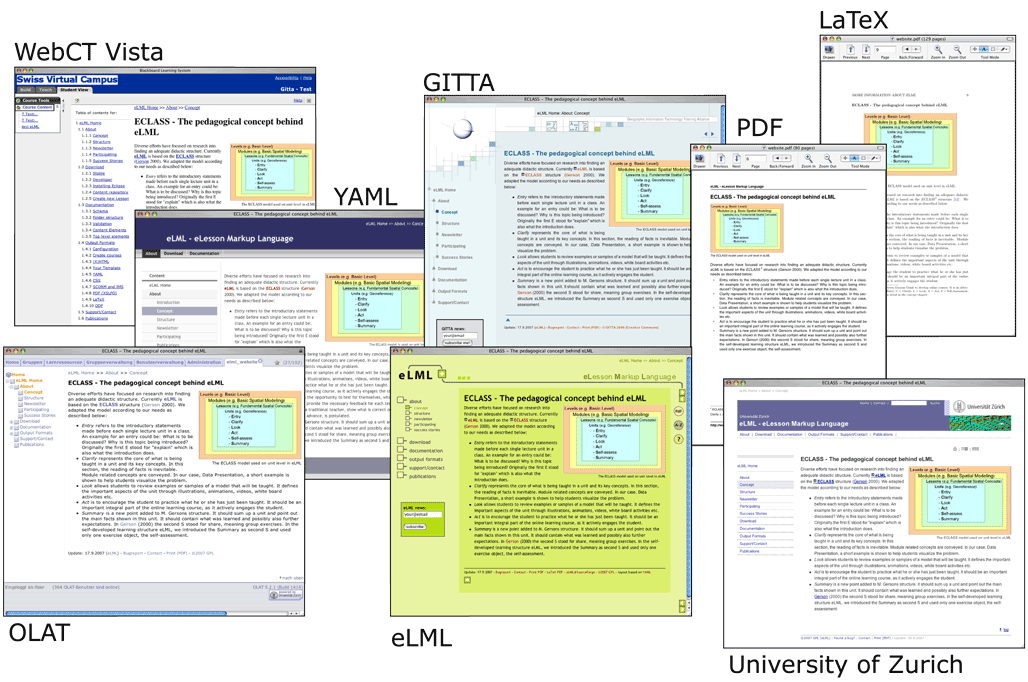
ELML
Encyclopedia
The eLesson Markup Language (eLML) http://www.eLML.org is an open source XML
framework for creating electronic lessons. It is a "spin-off" from the GITTA project http://www.gitta.info, a Swiss GIS eLearning project, and was launched in spring 2004. The eLML project is hosted at Sourceforge
and offers all the regular tools (CVS
, bugtracker, forum etc.) that you might already be familiar with when working with Sourceforge. The aim of eLML was to offer authors a tool that ensured conformity to pedagogical guidelines.
The original ECLASS model was slightly modified and e.g. additional elements like glossary, bibliography and metadata were added to be able to create a self-contained e-learning course. Furthermore the three elements clarify, look and act together form a so-called "learning object" and these elements can be used in any sequence order and can even be used multiple times within one learning object. This allows that an author can start with an example (look) and then follow by explaining the theory (clarify) behind it or the other way round. Also the uncommon but sometimes very successful approach where the student starts with a short exercise (act) and only after having tried out some solutions can read the theory (clarify) behind it and see some real world examples (look). The ECLASS model is on one hand flexible enough to represent different learning scenarios and to meet all the requirements needed by the creators of the e-learning lessons but ensures on the other hand that the content complies with the defined didactical guidelines.
These didactical guidelines where then mapped into an XML structure that allowed a strict checking if the author has correctly used the pedagogical model or not. The details are explained in detail below.

An eLML lesson always starts with either the mandatory introduction (element entry) or a concise listing of the lesson’s learning objectives (element goals). The unit elements, described below, contain the actual content of a lesson. Following the units a lesson can have a summary and/or up to five self-assessments followed by an optional further reading and glossary section to list important resources and to describe terms used within the lesson. The XML Schema ensures that all glossary terms used in a lesson are defined in the glossary. The Harvard Referencing System or the APA style
can be used for the bibliography. All citations, references, further readings etc., must be listed within the bibliography section, otherwise the XML parser issues an error and the lesson is not valid.
Through an amount of mandatory elements eLML ensures that at least the minimal metadata elements are filled out even though many authors do not like to fill in metadata information. The eLML metadata elements are a subset of the IMS Learning object metadata
(LOM) that can be used to store data about the length of the lessons, the author(s), copyrights, the required knowledge to attempt this lesson and the basic technical requirements. The bibliography style elements and the metadata section are defined in a separate XML schema and thus can be replaced by other standards or definitions.
Within each unit a similar structure as on lesson level is employed. However, the elements glossary, bibliography and metadata are always defined for the whole lesson on lesson level. The actual content within a unit is stored in a number of so-called "learning objects" (not to be confused with the learning objectives – called "goals" within eLML). Each learning object describes a certain concept, model, equation, term, or process using all or some of the three elements clarify (theory), look (example) and act in free order. These three elements can have a special visual representation when transformed into a presentation format – e.g. a "gear" icon for act elements as used in GITTA to signalize the student that he or she has to "do" something – but their main purpose is to guide authors while creating content. Using the elements clarify, look and act, the author has to think about how a certain concept can be presented best to the student. Whether a learning object starts with some theory (clarify element) and continues with one or more examples (look elements) or, alternatively, the student first does something (act element) and then read the theory afterwards (clarify element) is left to the author.
, XSLT
or SVG
all eLML lessons can be transformed and viewed with any web-browser on any platform and are totally software-independent. The two main transformation files that are included in the eLML package can transform a lesson into an "online" (both XHTML
1.1 and HTML5) and into a "print" (PDF) version (using XSL Formatting Objects
) with one click. Both version can be customized offering personalized layouts (see example below). More transformation files provided by eLML cover the following output formats: ODF
(Open Document Format), DocBook
, LaTeX
and since 2010 also eBooks based on the ePub
format. Since eLML supports both the IMS Global
"Content Package" and the SCORM
standard, the content can also easily be imported into any modern Learning Management System
(LMS) like WebCT
or OLAT
. To create nice looking templates eLML offers a tool called "Template Builder" and it has built-in support for a CSS-framework called YAML Please refer to the eLML website http://www.eLML.org for more technical background information. The following illustration shows an eLML lesson transformed into many different layouts and formats:

. The main communication between the community users goes via the Sourceforge
website, specially via the eLML-Users Mailinglist (for general issues) and the RFE (Feature Request) Tracker (for discussions about new features).
XML
Extensible Markup Language is a set of rules for encoding documents in machine-readable form. It is defined in the XML 1.0 Specification produced by the W3C, and several other related specifications, all gratis open standards....
framework for creating electronic lessons. It is a "spin-off" from the GITTA project http://www.gitta.info, a Swiss GIS eLearning project, and was launched in spring 2004. The eLML project is hosted at Sourceforge
SourceForge
SourceForge Enterprise Edition is a collaborative revision control and software development management system. It provides a front-end to a range of software development lifecycle services and integrates with a number of free software / open source software applications .While originally itself...
and offers all the regular tools (CVS
Concurrent Versions System
The Concurrent Versions System , also known as the Concurrent Versioning System, is a client-server free software revision control system in the field of software development. Version control system software keeps track of all work and all changes in a set of files, and allows several developers ...
, bugtracker, forum etc.) that you might already be familiar with when working with Sourceforge. The aim of eLML was to offer authors a tool that ensured conformity to pedagogical guidelines.
Pedagogical model behind eLML
The didactical fundament of eLML is the pedagogical model called ECLASS (Gerson, 2000 http://www.westga.edu/~distance/ojdla/winter34/gerson34.html). ECLASS is an abbreviation for the following elements:- Entry: Stands for the introduction into the lesson or a unit (the sub-category of a lesson)
- Clarify: A clarify element is used to explain some theory, models, principles or facts
- Look: Examples that help the student to understand the theory
- Act: This elements animates the student to become act, try out a model or discuss issues
- Self-Assessment: Check if the learning objectives of the lesson or unit were fulfilled
- Summary: Provides a brief summary of either the whole lesson or an individual unit
The original ECLASS model was slightly modified and e.g. additional elements like glossary, bibliography and metadata were added to be able to create a self-contained e-learning course. Furthermore the three elements clarify, look and act together form a so-called "learning object" and these elements can be used in any sequence order and can even be used multiple times within one learning object. This allows that an author can start with an example (look) and then follow by explaining the theory (clarify) behind it or the other way round. Also the uncommon but sometimes very successful approach where the student starts with a short exercise (act) and only after having tried out some solutions can read the theory (clarify) behind it and see some real world examples (look). The ECLASS model is on one hand flexible enough to represent different learning scenarios and to meet all the requirements needed by the creators of the e-learning lessons but ensures on the other hand that the content complies with the defined didactical guidelines.
These didactical guidelines where then mapped into an XML structure that allowed a strict checking if the author has correctly used the pedagogical model or not. The details are explained in detail below.
The XML structure of eLML
The described pedagogical model ECLASS is mapped onto an XML structure using XML Schema, as shown in this illustration:
An eLML lesson always starts with either the mandatory introduction (element entry) or a concise listing of the lesson’s learning objectives (element goals). The unit elements, described below, contain the actual content of a lesson. Following the units a lesson can have a summary and/or up to five self-assessments followed by an optional further reading and glossary section to list important resources and to describe terms used within the lesson. The XML Schema ensures that all glossary terms used in a lesson are defined in the glossary. The Harvard Referencing System or the APA style
APA style
American Psychological Association Style is a set of rules that authors use when submitting papers for publications in APA journals. The APA states that they were developed to assist reading comprehension in the social and behavioral sciences, for clarity of communication, and to "move the idea...
can be used for the bibliography. All citations, references, further readings etc., must be listed within the bibliography section, otherwise the XML parser issues an error and the lesson is not valid.
Through an amount of mandatory elements eLML ensures that at least the minimal metadata elements are filled out even though many authors do not like to fill in metadata information. The eLML metadata elements are a subset of the IMS Learning object metadata
Learning object metadata
Learning Object Metadata is a data model, usually encoded in XML, used to describe a learning object and similar digital resources used to support learning...
(LOM) that can be used to store data about the length of the lessons, the author(s), copyrights, the required knowledge to attempt this lesson and the basic technical requirements. The bibliography style elements and the metadata section are defined in a separate XML schema and thus can be replaced by other standards or definitions.
Within each unit a similar structure as on lesson level is employed. However, the elements glossary, bibliography and metadata are always defined for the whole lesson on lesson level. The actual content within a unit is stored in a number of so-called "learning objects" (not to be confused with the learning objectives – called "goals" within eLML). Each learning object describes a certain concept, model, equation, term, or process using all or some of the three elements clarify (theory), look (example) and act in free order. These three elements can have a special visual representation when transformed into a presentation format – e.g. a "gear" icon for act elements as used in GITTA to signalize the student that he or she has to "do" something – but their main purpose is to guide authors while creating content. Using the elements clarify, look and act, the author has to think about how a certain concept can be presented best to the student. Whether a learning object starts with some theory (clarify element) and continues with one or more examples (look elements) or, alternatively, the student first does something (act element) and then read the theory afterwards (clarify element) is left to the author.
Transformation and Presentation of an eLML lesson
Thanks to the use of standards like XMLXML
Extensible Markup Language is a set of rules for encoding documents in machine-readable form. It is defined in the XML 1.0 Specification produced by the W3C, and several other related specifications, all gratis open standards....
, XSLT
XSLT
XSLT is a declarative, XML-based language used for the transformation of XML documents. The original document is not changed; rather, a new document is created based on the content of an existing one. The new document may be serialized by the processor in standard XML syntax or in another format,...
or SVG
Scalable Vector Graphics
Scalable Vector Graphics is a family of specifications of an XML-based file format for describing two-dimensional vector graphics, both static and dynamic . The SVG specification is an open standard that has been under development by the World Wide Web Consortium since 1999.SVG images and their...
all eLML lessons can be transformed and viewed with any web-browser on any platform and are totally software-independent. The two main transformation files that are included in the eLML package can transform a lesson into an "online" (both XHTML
XHTML
XHTML is a family of XML markup languages that mirror or extend versions of the widely-used Hypertext Markup Language , the language in which web pages are written....
1.1 and HTML5) and into a "print" (PDF) version (using XSL Formatting Objects
XSL Formatting Objects
XSL Formatting Objects, or XSL-FO, is a markup language for XML document formatting which is most often used to generate PDFs. XSL-FO is part of XSL , a set of W3C technologies designed for the transformation and formatting of XML data. The other parts of XSL are XSLT and XPath...
) with one click. Both version can be customized offering personalized layouts (see example below). More transformation files provided by eLML cover the following output formats: ODF
ODF
ODF may be an acronym for:* OpenDocument format, a standard for electronic office documents** OpenDocument Fellowship, a volunteer organisation with members around the world to promote the use and development of the OpenDocument format....
(Open Document Format), DocBook
DocBook
DocBook is a semantic markup language for technical documentation. It was originally intended for writing technical documents related to computer hardware and software but it can be used for any other sort of documentation....
, LaTeX
LaTeX
LaTeX is a document markup language and document preparation system for the TeX typesetting program. Within the typesetting system, its name is styled as . The term LaTeX refers only to the language in which documents are written, not to the editor used to write those documents. In order to...
and since 2010 also eBooks based on the ePub
EPUB
EPUB is a free and open e-book standard by the International Digital Publishing Forum...
format. Since eLML supports both the IMS Global
IMS Global
IMS Global Learning Consortium is a global, nonprofit, member organization that strives to enable the growth and impact of learning technology in the education and corporate learning sectors worldwide...
"Content Package" and the SCORM
SCORM
Sharable Content Object Reference Model is a collection of standards and specifications for web-based e-learning. It defines communications between client side content and a host system called the run-time environment, which is commonly supported by a learning management system...
standard, the content can also easily be imported into any modern Learning Management System
Learning management system
A learning management system is a software application for the administration, documentation, tracking, and reporting of training programs, classroom and online events, e-learning programs, and training content...
(LMS) like WebCT
WebCT
WebCT or Blackboard Learning System, now owned by Blackboard, is an online proprietary virtual learning environment system that is sold to colleges and other institutions and used in many campuses for e-learning...
or OLAT
OLAT
OLAT is an acronym for Online Learning And Training. It is a web application – a so called Learning Management System that supports any kind of online learning, teaching, and tutoring with few educational restrictions. OLAT is free software and is open source. Its development started in 1999 at the...
. To create nice looking templates eLML offers a tool called "Template Builder" and it has built-in support for a CSS-framework called YAML Please refer to the eLML website http://www.eLML.org for more technical background information. The following illustration shows an eLML lesson transformed into many different layouts and formats:

Tools for eLML
Starting with version 5, eLML offers a wide range of tools: The Firedocs eLML Editor to create lessons (based on the Firedocs Mozilla Firefox XML-Editor, the Template Builder to create layout templates (created as a Google Summer of Code project), and Add-On's for Apache Lenya CMS etc. With eLML 7 release a new transformation tool to create online lessons in various formats was launched: EasyELML.  |
 |
Copyright and legal issues
eLML is an open source project and available under the Apache 2 LicenseApache License
The Apache License is a copyfree free software license authored by the Apache Software Foundation . The Apache License requires preservation of the copyright notice and disclaimer....
. The main communication between the community users goes via the Sourceforge
SourceForge
SourceForge Enterprise Edition is a collaborative revision control and software development management system. It provides a front-end to a range of software development lifecycle services and integrates with a number of free software / open source software applications .While originally itself...
website, specially via the eLML-Users Mailinglist (for general issues) and the RFE (Feature Request) Tracker (for discussions about new features).
See also
- Category:Free educational software
- Category:Authoring system
- Category:Free learning support software
- Category:Virtual learning environments
- Category:2004 software

